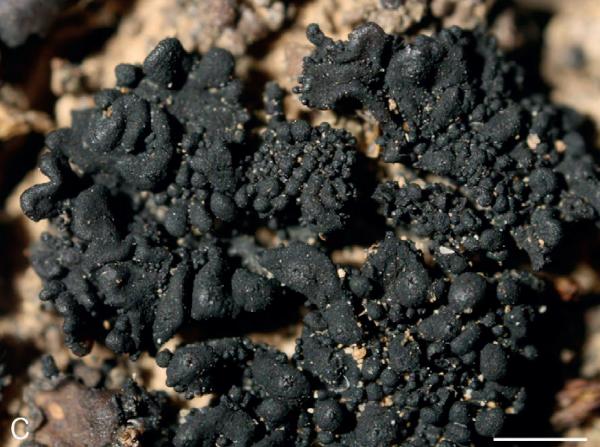Peccania cernohorskyi (Servít) Schiman-Czeika, Czeika & Guttová
in Czeika & al., Preslia, 76 2: 187, 2004. Basionym: Thyrea cernohorskyi Servít - Věstn. Král. České Společ. Nauk, Třída Math.-Přírod., 4: 6, 1935 (1934)
Synonyms: Anema cernohorskyi (Servít) Henssen
Distribution:
Description: Thallus subsquamulose-peltate, attached by a single central strand of rhizohyphae, black when dry, dark olive-brown when wet, with short, cylindrical to slightly flattened lobes covered with globose, isidia-like outgrowths. Thallus ecorticate, the peripheral part with a loose network of anticlinally oriented hyphae enclosing the photobiont, the inner part with an irregular, axial strand made of longitudinally oriented hyphae. Apothecia terminal to submarginal, at first urceolate then clearly lecanorine, 1-1.5 mm across, round to irregular in outline, with a dark brown to black disc and a thick, prominent thalline margin. Proper exciple absent; epithecium yellowish brown, poorly differentiated from the hymenium, with dark orange-brown patches; hymenium colourless, but with conspicuous brown to red-brown patches in the upper third, I+ blue; paraphyses branched and anastomosing, constricted at septa, capitate; hypothecium yellowish brown. Asci 8-spored, broadly clavate, thin-walled, with a distinct gelatinose, amyloid outer cap, but no apical dome, Peccania-type. Ascospores 1-celled, hyaline, globose to subglobose, 12-15 x 12-14 μm. Pycnidia immersed, globose to pyriform, unilocular. Conidia 1-celled, hyaline, thread-like, (16-)19-25 x c. 1 μm. Photobiont cyanobacterial, chroococcoid, with single or paired cells often penetrated by haustoria, surrounded by a yellowish brown gelatinous sheath which tends to become thinner and paler in internal parts. Spot test: all negative. Chemistry: without lichen substances.Note: on thin layers of soil or directly on basic or calciferous siliceous rocks; apparently rare in Central Europe, also known from the Southern Alps (France), but on calcareous rocks (hence records in need of confirmation), often confused with Anema-species and perhaps more widespread. To be looked for in Italy
Growth form: Squamulose
Substrata: rocks, soil, terricolous mosses, and plant debris
Photobiont: cyanobacteria, coccaceous (e.g. Gloeocapsa)
Reproductive strategy: mainly asexual, by isidia, or isidia-like structures (e.g. schizidia)
On otherwise dry surfaces with short periods of water seepage after rain

Predictive model
Growth form: Squamulose
Substrata: rocks, soil, terricolous mosses, and plant debris
Photobiont: cyanobacteria, coccaceous (e.g. Gloeocapsa)
Reproductive strategy: mainly asexual, by isidia, or isidia-like structures (e.g. schizidia)
On otherwise dry surfaces with short periods of water seepage after rain

Predictive model



